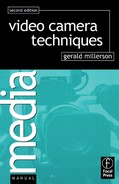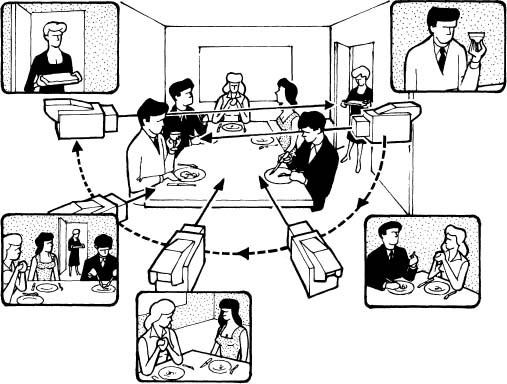In a developing shot, the camera explores the scene as it moves on from one subject to another, or from one viewpoint to the next. It presents a smooth-flowing sequence of pictures, which build up an illusion of space and direction in the audience’s mind.
You can use the developing shot for several purposes:
• To establish location – As the camera searches, it slowly reveals exactly where we are; e.g. panning past a series of items in glass cases, to establish that the scene of the action is a museum.
• Realization – The camera gradually introduces us to a situation; e.g. we see that the rising tide has cut off the travelers’ escape.
• Comparison – Panning over a series of items in a collection, we can compare their style, color, etc.
• To show relationships – Demonstrating how one item relates to another; e.g. how far climbers have reached on a mountain.
Developing shots are frequently used when the mood is solemn or romantic. The pace (tempo) during the shot is unusually slow, for it is intended to encourage growing interest, or to build up tension. The big advantage of this type of shot, is that it avoids the visual disruptions of cutting between different viewpoints. There is a greater sense of audience involvement.
The mechanics of developing shots
Developing shots can involve very skilled, carefully controlled camera operation. As you move the camera mounting (dollying, trucking, arcing), framing and focus need to be corrected unobtrusively as the picture continually changes. Depth of field will vary. Not only must the camera move around smoothly, but you need to avoid any potential obstacles (e.g. furniture). It’s important to avoid indecision, hesitation, uncoordinated movements or focusing slip-ups during a developing shot, for this would draw attention to the mechanics.
You may prefer to use a fairly wide lens angle for developing shots, as it makes handling easier and provides greater depth of field. But the camera would then have to work closer than with a normal lens angle – otherwise subjects would look too distant. There are also the hazards of distortion and shadowing problems. Certainly you should avoid a narrow-angle lens with its inevitable handling problems. And remember too, you will not have the opportunity to pre-focus any close-ups.
Try to use the same kind of dolly movement throughout. Changing from e.g. dolly to truck, is likely to cause the picture to bounce. Judiciously adjusting the lens angle instead, can simplify a dolly move; e.g. zooming in at the end of a long trucking move, rather than changing the mounting’s direction on shot to dolly in to detail.
The varying viewpoint
The camera changes its viewpoint in a continuous exploratory movement, showing various aspects of the action.

